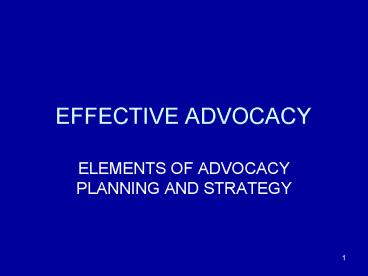EFFECTIVE ADVOCACY - PowerPoint PPT Presentation
1 / 21
Title:
EFFECTIVE ADVOCACY
Description:
Advocacy Planning Problem Identification and Analysis ... Helps to ensure advocacy responds to political opportunities and follows priorities ... – PowerPoint PPT presentation
Number of Views:44
Avg rating:3.0/5.0
Title: EFFECTIVE ADVOCACY
1
EFFECTIVE ADVOCACY
- ELEMENTS OF ADVOCACY PLANNING AND STRATEGY
2
Elements of advocacy?
- What is advocacy?
3
Elements of advocacy
- Process of using information strategically to
change policies that affect the lives of people - Changing policies and practices
4
Elements of advocacy
- Distinction between advocacy activity and service
activity - Aim of advocacy s to change policies or practices
- Providing a service can result in advocacy
activity
5
Elements of Advocacy
- What are the elements of advocacy?
6
Elements of Advocacy
- Networking and coalition building
- Identifying resources and fundraising
- Information and research
- Communications and Media
- Planning and Evaluation
- Lobbying
7
Elements of Advocacy Networking and Coalition
Building
- Bolster advocacy efforts
- Bring together strength and resources of diverse
groups - Determining composition of coalition and networks
depends on the goals and objectives of advocacy
8
Elements of Advocacy - Resources and Fundraising
- Resources
- Staff
- Facilities
- Knowledge
- Include advocacy in budgets
9
Elements of Advocacy Information and Research
- Importance of information gathering
- Research for advocacy purposes
- Empowering beneficiaries
- Ethics of research
10
Elements of advocacy Communications and Media
- Communications transmission of information and
message through different means
11
Elements of Advocacy Planning and Evaluation
- Why is planning and evaluation necessary?
- Limited resources
- Limited timeframes
- Importance of accountability
- Need to achieve concrete results
- Need to have common aim
12
Advocacy Planning Participation
- Importance of participation by staff, boards and
beneficiaries - Generates commitment
- Creates shared ideals and directions
- Identify and cope with conflicts and differences
- Improve accountability
- Increase self-confidence
13
Advocacy Planning Key Steps
- Personal and organizational assessment
- Contextual analysis
- Problem identification and analysis
- Choosing and Framing the Advocacy Issue
- Long-term and short-term goals
- Power mapping
- Policy and situational research
- Advocacy objectives
- Activities, actions, tactics and implementation
- Ongoing evaluation
14
Advocacy Planning Personal and organizational
assessment
- Review and analysis of vision, missions and
strategies
15
Advocacy Planning Contextual Analysis
- Understanding political context at local,
country, regional and global levels
16
Advocacy Planning Problem Identification and
Analysis
- Define and prioritize issues for potential
advocacy
17
Advocacy planning
- Choosing and framing the advocacy issue -
analysis of issue and exploration of possible
solutions - Long-term and Short-term advocacy goals
18
Advocacy Planning Power Mapping
- Helps to identify targets, allies, opponents and
beneficiaries - Examines stakeholders interests, positions and
conflicts. - Essential for planning, negotiating and
calculating risks.
19
Advocacy Planning Policy and Situational
Research
- Gather information on policies, laws, programs,
budgets affecting issue - Makes advocacy clearer and provides material for
communications and media work, outreach, lobbying
and negotiations
20
Advocacy Planning Objectives
- Objectives will set out desired changes in policy
and decision making structures and how objectives
will improve beneficiary's lives
21
Advocacy Planning Activities and Evaluation
- After completing above activities, create a plan
which identifies the actions, tactics and
implementation - Evaluation vital
- Helps to ensure advocacy responds to political
opportunities and follows priorities - Permits adjusting activities to changing
situations































